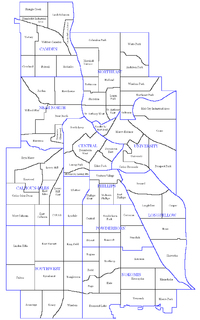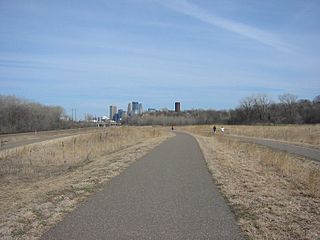 | |
|---|---|
| North end | Lyndale Ave at N 41st Ave, Minneapolis |
| South end | |
Washington Avenue is a major thoroughfare in Minneapolis, Minnesota. Starting north of Lowry Avenue, the street runs straight south, with Interstate 94 running alongside it until just south of West Broadway, when the freeway turns to the west. Washington continues running straight until just south of Plymouth Avenue, where it turns in a southeasterly direction heading for Downtown Minneapolis. It forms the main thoroughfare through the Warehouse District.
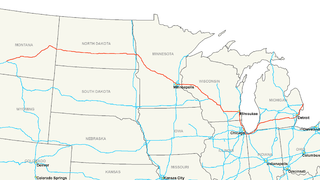
Interstate 94 (I-94) is an east–west Interstate Highway connecting the Great Lakes and northern Great Plains regions of the United States. Its western terminus is in Billings, Montana, at a junction with I-90; its eastern terminus is in Port Huron, Michigan, where it meets with I-69 and crosses the Blue Water Bridge into Sarnia, Ontario, Canada, where the route becomes Ontario Highway 402. It thus lies along the primary overland route from Seattle to Toronto, and is the only east–west Interstate highway to form a direct connection into Canada.
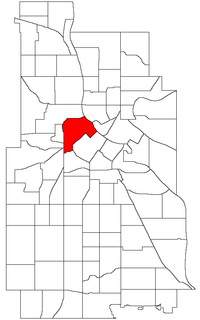
The North Loop is a neighborhood of the Central community of Minneapolis, Minnesota. The neighborhood is commonly known as the Warehouse District from the city's shipping hub years. It includes the Minneapolis Warehouse Historic District which is listed on the National Register of Historic Places. The North Loop is located just northwest of the central business district between downtown Minneapolis and the Mississippi River. Streets in the North Loop are oriented to be parallel to the river, which means that they run at a 45-degree angle relative to the grid of the rest of the city.
The scenery changes at Hennepin Avenue. This area, once known as the Gateway District, was heavily affected by urban renewal policies of the 1950s, destroying what had at one point been the heart of the city. Dozens of city blocks were bulldozed and replaced with modern glass structures - or in many cases, surface parking lots. The portion of the street from Hennepin to what is now Interstate 35W was widened and a median was added.
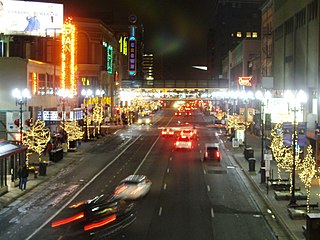
Hennepin Avenue is a major street in Minneapolis, Minnesota, United States. It runs from Lakewood Cemetery, north through the Uptown District of Southwest Minneapolis, through the Virginia Triangle, the former "Bottleneck" area west of Loring Park. It then goes through the North Loop in the city center, to Northeast Minneapolis and the city's eastern boundary, where it becomes Larpenteur Avenue as it enters Lauderdale in Ramsey County at Highway 280. Hennepin Avenue is a Minneapolis city street south/west of Washington Avenue, and is designated as Hennepin County Road 52 from Washington Avenue to the county line.

The Gateway District of Minneapolis is centered at the convergence of Hennepin Avenue, Nicollet Avenue, and Washington Avenue. Its borders are not officially designated or recognized, but are visible as the Mississippi River to the northeast, First Avenue North to the northwest, Fifth Avenue South to the southeast. and Fourth Street South to the southwest. The district includes a significant part of the Downtown West neighborhood and five blocks of the North Loop.
Interstate 35W (I-35W) is an Interstate Highway in the U.S. state of Minnesota, passing through downtown Minneapolis. It is one of two through routes for I-35 through the Twin Cities of Minneapolis and Saint Paul, the other being I-35E through downtown Saint Paul. I-35 splits into two branch routes: I-35W, which serves Minneapolis, and I-35E, which serves Saint Paul.
Further changes occurred to the east of the Interstate. Washington used to turn at the Seven Corners intersection (where Washington meets Cedar Avenue) and continue across the old Washington Avenue Bridge into Southeast Minneapolis. However, the old bridge was replaced in the 1960s with a new one which meets Washington east of the Mississippi River but doesn't connect with Washington west of it, instead connecting to a short freeway stub into downtown. There is a one-block portion of the old alignment between Cedar and 19th Avenues that is branded as Washington Avenue, but to continue east of the river, one must travel down Cedar one block and turn east at 3rd Street and get on an entrance ramp to the bridge.
Cedar Avenue is a roadway that runs from Minneapolis to Northfield, Minnesota. It is Minnesota State Highway 77 in the busiest portion of the route, from Minneapolis to Apple Valley. The portions north and south of this are county roads, Hennepin County 152 and Dakota County 23, respectively. Its northern terminus in Minneapolis is at Washington Avenue in Cedar-Riverside, though its alignment is briefly interrupted by an interchange at Hiawatha Avenue to the south.

The Washington Avenue Bridge carries County Road 122 and the METRO Green Line light rail across the Mississippi River in Minneapolis, Minnesota and connects the East Bank and West Bank portions of the University of Minnesota's main campus. The bridge has two decks, with the lower deck designated for motor vehicle traffic and light rail trains and the upper deck used for pedestrians and bicycles. It is a utilitarian structure with simple architecture, but it has cultural significance because thousands of students, faculty, staff, and visitors walk across it every day.

Hennepin County Road 122 or County State-Aid Highway 122 is an unsigned county state-aid highway within the city of Minneapolis, Hennepin County, Minnesota, United States, crossing the Mississippi River on the Washington Avenue Bridge.
East of the river, Washington Avenue acts as a major thoroughfare through the University of Minnesota campus; much of this section has been converted to a transit mall to facilitate the METRO Green Line, opened in June 2014. At the intersection of Oak Street and Washington is the Stadium Village area. The street continues east for a few more blocks before ending at University Avenue.

A transit mall is a street, or set of streets, in a city or town along which automobile traffic is prohibited or greatly restricted and only public transit vehicles, bicycles, and pedestrians are permitted.

Stadium Village is an area of Minneapolis, Minnesota near the East Bank campus of the University of Minnesota. While not an official neighborhood of Minneapolis, the area is an important commercial district that serves university students with many bars and restaurants. There are plans to incorporate it into an official neighborhood of Minneapolis along with the surrounding area. It is part of Southeast Minneapolis, that part of Minneapolis on the East Bank of the Mississippi River and south of Hennepin Avenue
The city and Minneapolis mayor R. T. Rybak have assembled a design team who propose a park, trees and a 10-year action plan for the avenue. [1]

Raymond Thomas "R. T." Rybak Jr. is an American politician, journalist, businessperson, and activist who served as the 46th mayor of Minneapolis. In the 2001 election Rybak defeated incumbent Sharon Sayles Belton by a margin of 65% to 35%, the widest margin of victory over an incumbent mayor in city history. He took office in January 2002, and won a second term in 2005 and a third in 2009. In late December 2012, he announced he would not run for another term and was going to be concentrating on his family. Rybak called being mayor his "dream job."
